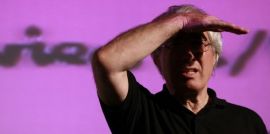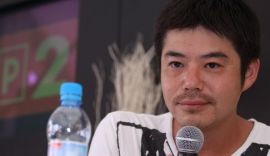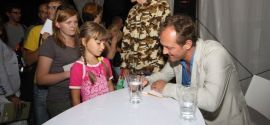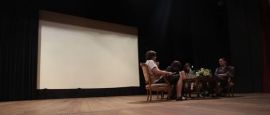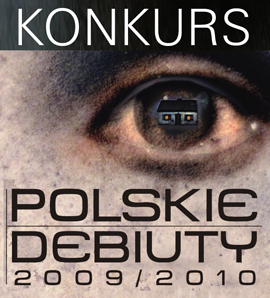Carl Th. Dreyer: Retrospective
We have good news for all classic movies fans. As announced before, on the TWO RIVERSIDES Festival we are going to present works of Carl Th. Dreyer, director who had a huge influence on development of the cinema. His highly intense, in terms of form and message, pictures aroused controversy, but at the same time impelled religious cogitation. Dreyer, raised in Lutheran family, focused in his works on the conflict between man and institution: state and religious alike.
On The TWO RIVERSIDES Festival we will present sixteen films of this remarkable director. Features: “Gertrud”, “The Passion of Joan of Arc” (La Passion de Jeanne d’Arc), “Michael”, “Love One Another” (Die Gezeichnete), “Once Upon A Time” (Der var engang), “The Word” (Ordet), “Vampyr” and “The Parson’s Widow” (Prästänkan).
Shorts: “Good Mothers” (Mødrehjælpen), “They Caught the Ferry” (De nåede far gen), “The Danish Village Church” (Landsbykirken), “The Storstrom Bridge” (Storstrømsbroen), “Thorvaldsen”, The “Fight Against the Cancer” (Kampen mod kræften), “Water from the Land” (Vandet på landet) and “A Castle Within the Castle” (Et slot i et slot | Krogen og Kronborg).
CARL TH. DREYER
 The Danish director Carl Th. Dreyer (1889-1968) is often regarded as a filmmaker who stood apart from everyone else. But he was quite willing to admit to the influence of and the admiration for certain other filmmakers, particularly the Swedish director Victor Sjöström. Sjöström was the major figure of the golden age of Swedish silent film with pictures like ”The Phantom Carriage” and ”The Sons of Ingmar”. Dreyer admired him intensely for his commitment to realism and his psychological subtlety. Many of Sjöström’s films were based on famous novels and set in the past against the dramatic background of the Nordic landscape, and after his apprenticeship at Nordisk, Dreyer in 1920 got the chance to make a film for a Swedish production company that followed the mold of the Sjöström films quite closely. This was ”The Parson’s Widow”, shot on location in Norway at the Maihaugen open air museum. Dreyer used authentic 17th-century buildings in this film and thought that that was a wonderful experience. These films using the Nordic landscape and famous literary works as a basis were known as national films at the time, and this was something that the Danish film industry had not really followed up on. In 1922, however, Dreyer tried his hand at making a really Danish national film, ”Once Upon A Time”, based on the play by Holger Drachmann, which was a great success at the time.
The Danish director Carl Th. Dreyer (1889-1968) is often regarded as a filmmaker who stood apart from everyone else. But he was quite willing to admit to the influence of and the admiration for certain other filmmakers, particularly the Swedish director Victor Sjöström. Sjöström was the major figure of the golden age of Swedish silent film with pictures like ”The Phantom Carriage” and ”The Sons of Ingmar”. Dreyer admired him intensely for his commitment to realism and his psychological subtlety. Many of Sjöström’s films were based on famous novels and set in the past against the dramatic background of the Nordic landscape, and after his apprenticeship at Nordisk, Dreyer in 1920 got the chance to make a film for a Swedish production company that followed the mold of the Sjöström films quite closely. This was ”The Parson’s Widow”, shot on location in Norway at the Maihaugen open air museum. Dreyer used authentic 17th-century buildings in this film and thought that that was a wonderful experience. These films using the Nordic landscape and famous literary works as a basis were known as national films at the time, and this was something that the Danish film industry had not really followed up on. In 1922, however, Dreyer tried his hand at making a really Danish national film, ”Once Upon A Time”, based on the play by Holger Drachmann, which was a great success at the time.
Previously, Dreyer had made the film ”Die Gezeichneten” in Germany. This film about the horrors of anti-semitism and progroms against Jews in tsarist Russia showed his intense commitment to realism. His experience working in real buildings in Norway for ”The Parson’s Widow” was followed up in this film: he had his set designer Jens Lind design sets with four walls and movable sections so that he could place his camera all around the actors. Also, the sets were closely based on actual buildings. Dreyer and his set designer went to Lublin and looked at buildings in the Jewish quarter there, which they copied for the film. Although ”Die Gezeichneten” was shot in Germany and set in Tsarist Russia, it was based on a novel by a Danish author, and when Dreyer returned to Germany in 1923 after making ”Once Upon a Time”, he once again chose a Danish novel to work from. ”Michael” by Herman Bang, an author who was very well known in the German-speaking world at the time. In ”Michael”, Dreyer tried to follow the conventions of the chamber drama, creating a psychologically realist study. Reviewers at the time praised the subtlety of the acting in the film – amongst others by the great Danish director Benjamin Christensen – but it was not as widely exported as the German production company had probably hoped, possibly because there is the suggestion of homosexuality in the film’s central love story.
Dreyer returned to Denmark and shot another chamber drama, ”Master of the House”, which was a great success in France and gave him the opportunity to work there. Somewhat reluctantly, he embarked on the project of making a film about Joan of Arc. Once he had decided that he would eliminate everything to do with Joan’s military career and concentrate on her trial and execution, he warmed considerably to the subject, however. He studied the transcripts of the trial in great detail. He had a very large budget to make ”La Passion de Jeanne d’Arc” and built sets of considerable size. He also shot the film in sequence, beginning with the beginning and ending with the end which added considerably to the expense, because all the many actors appearing had to be paid throughout the production, which lasted for seven months. The vast sets are strongly stylized. They were designed to resemble the kinds of buildings you find in the pictures in illuminated medieval manuscripts from the fifteenth century, several of which Dreyer studied while preparing the script and which clearly helped influence the design of the film. In addition to this stylization of the sets he employed extreme montage effects.
His next film, ”Vampyr”, was shot in 1930. He made it for his own production company; the money came from a wealthy young man who agreed to pay for the film in exchange for playing the main role. The film is a strange and dreamlike study of how the mind reacts to the supernatural. Haunting and brilliantly made, it was nevertheless rejected by audiences, and Dreyer was unable to find film work for a full ten years and experienced considerable financial difficulties. In 1942, he was able to make a short film, ”Mødrehjælpen”, which showed that he had not lost his skill. The following year, he was able to make the great ”Day of Wrath”, a very intense study of the witchcraft persecutions during the seventeenth century. This film was internationally distributed after World War II; it showed that Dreyer had once again taken his place among the major directors of the time.
Apart from a Swedish film made in 1945 which he disowned, for the next several years Dreyer kept himself employed by making short films for the Danish government. They are generally well-made, but Dreyer’s main concern was a project he had initially embarked on as early as 1930, namely that of making a film about Jesus. His aim, according to his own writings, was to show that the old accusation against the Jews that they were Christ-killers was false; to show that Jesus was a victim of the Roman occupying power. His film was explicitly intended to be an anti-anti-Semitic film; he wanted to shoot it in the original languages and have Jesus played by a Jewish actor. The project proved very difficult to bring off, and in 1954 he began to make his next feature film, ”Ordet”. In a sense, ”Ordet” can be seen as a kind of study for the Jesus film. His interest was particularly in how it might be possible to portray a psychologically and emotionally convincing miracle on the screen, and in a sense the whole of Ordet is designed for this purpose: to make the miracle at the end credible and believable.
Towards the end of his life, he became more and more interested in the form of classical tragedy. In some ways, that is how he saw Gertrud. The classical tragedy is the story of how the hubris of the hero leads to catastrophe. The hubris here is that of the heroine Gertrud, her refusal to compromise her idealistic conception of love; and this is what in the end results in unhappiness for the characters. The formal extremity of the film, the way the characters are made to speak like living statues, is the culmination of his striving to make the dialogue in the films stand out, to give each line the greatest possible weight; and it is likely that this is likely that this is also the form he intended his Jesus film to take.
Casper Tybjerg




